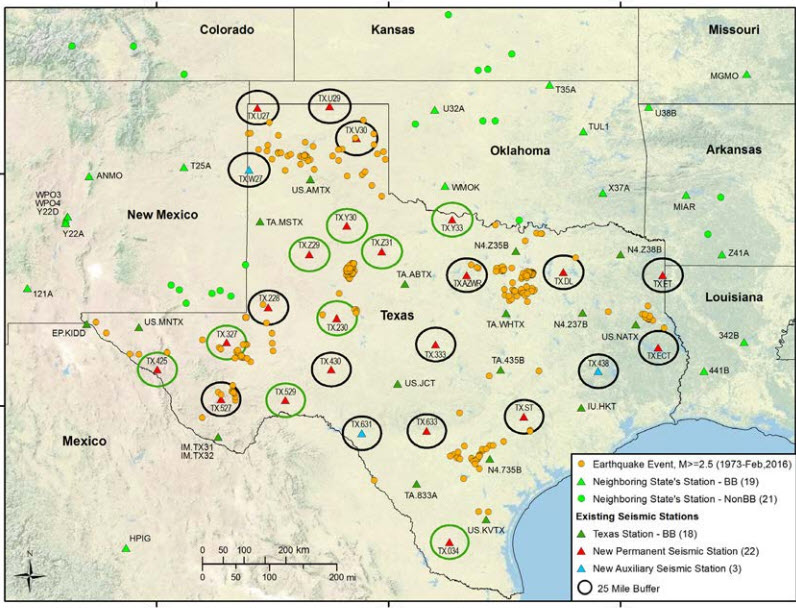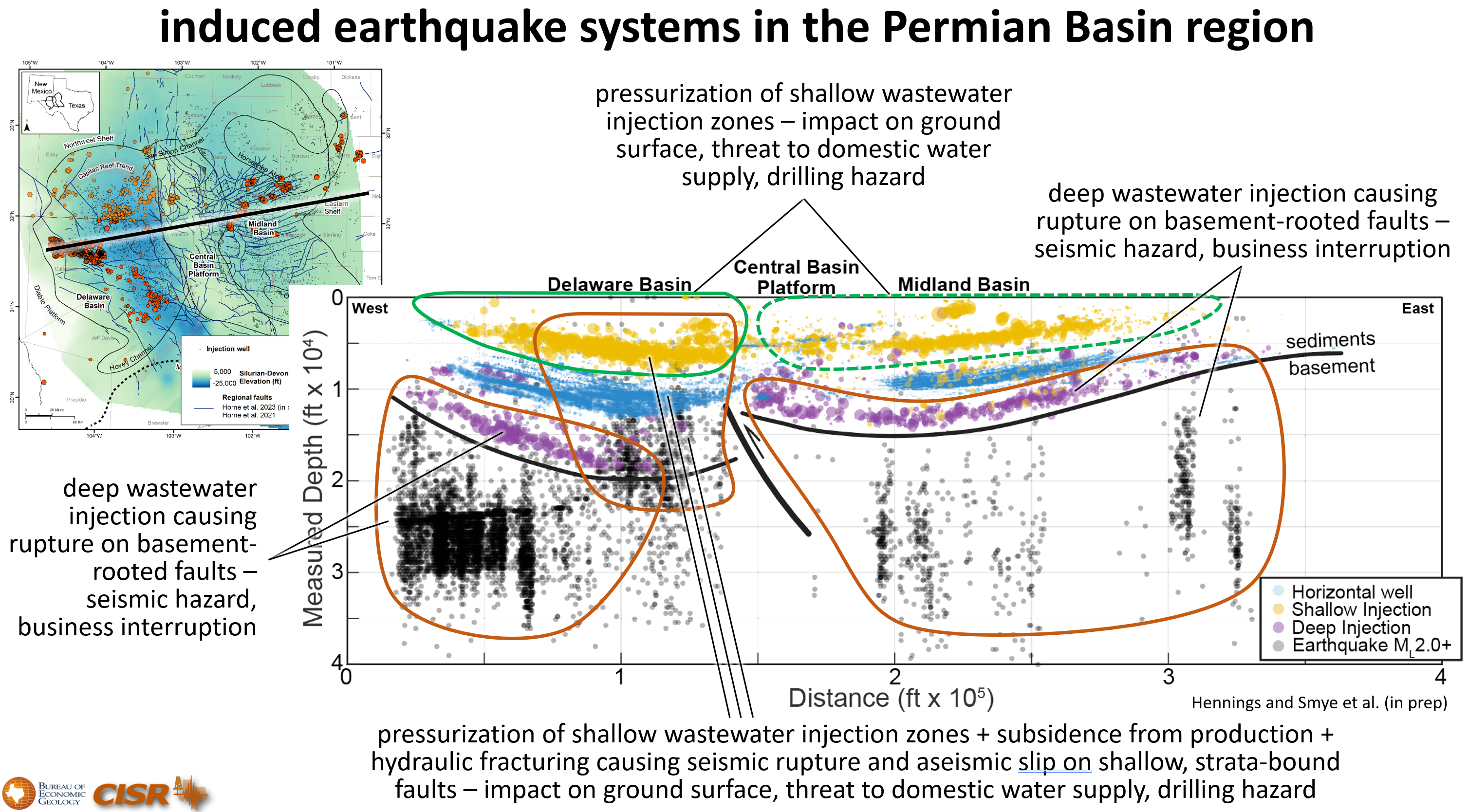HGS E & E Meeting: Injection-Induced Earthquakes
In order to register, please click login to either sign in to an existing account or create a user profile. Go to the HGS home page and login with your user name and password and then return to this page in order to register as a member or guest of a member. For help registering contact the HGS office or email webmaster@hgs.org. Thank you!
Wednesday,
Craft Republic Houston • 11470 Westheimer Rd.
Social 5:30 p.m., Dinner 6:30 p.m., Presentation 7:30- 9:00 p.m.
Cost: $35 Pre-registered members; $40 non-members & ALL walk-ups
To guarantee a seat, you must pre-register on the HGS website and pay with a credit card. You may walk up and pay at the door if extra seats are available. Please cancel by phone or email within 24 hours before the event for a refund. Online & pre-registration closes Wednesday, at 5:00 a.m.
Injection-Induced Earthquakes – Understanding the Cases in Texas as Studied by the Center for Injection and Seismicity Research (CISR)
speaker: Peter Hennings Principal Investigator – Center for Injection and Seismicity Research (CISR), Jackson School of Geosciences Bureau of Economic Geology, The University of Texas at Austin
watch a video about this topic on YouTube
From 2010 through 2023 there were over 1,300 M3.0+ earthquakes of presumed induced origin in Texas and southeast New Mexico. The TexNet Earthquake Monitoring Network and its partner seismic networks have been providing detailed information on seismicity in the region since 2017. CISR has integrated this data and comprehensive geological, geophysical, and geomechanical interpretations in five regional geologic systems to understand the subsurface conditions and injection practices that promote fault rupture and earthquakes. Three of these systems are the injection-induced ruptures of basement-rooted faults in the Fort Worth Basin, which sits under urban populations of more than 9 million people, the northern Delaware Basin, and the central Midland Basin. The inducement mechanism for these systems is an increase in pore pressure, and therefore stress, from injection into strata above the basement. Because basement faults host these ruptures, the local magnitudes can be relatively large, with events of ML5.0+ recorded. For earthquakes associated with basement ruptures, we find pore pressure increases of up to 450 psi proximal to large-scale injection and strongly variable temporal variations in injection rate. In contrast, some ruptures are associated with pore pressure increases of ~10 psi for cases where the area perturbed is large, the distance between injection wells and ruptured faults is up to 30 km, and the most sensitive faults have been triggered. The most active sets of ruptures in this system are within the Culberson-Mentone zone in the Delaware Basin, which sits distally from areas of large-scale injection, and where changes in pore pressure are on the order of 0-75 psi. This implies that poroelastic stressing must play a role, acting at greater distances than pore pressure change alone. This mix of proximal and distal inducement in the northern Delaware Basin and the Midland Basin is like that observed for inducement in northern Oklahoma, Kansas, and in the Fort Worth Basin of Texas.
The fourth induced seismicity system is within Permian-age shales and shallower strata in the southcentral Delaware Basin and is caused by rupture of strata-bound faults that do not extend into the basement. This geomechanically complex inducement is caused by injection into the Delaware Mountain Group (DMG), hydraulic fracturing (HF) of the underlying shales, and variable depletion and compaction of the shales associated with production. Host formation lithology and the strata-bound nature of these fault ruptures reduce the observed maximum magnitude to ≤ML3.5, with rare exceptions. Many of these seismogenic faults have been made neotectonically active and deform the ground surface due to both injection and production. Some of these shallow faults have tips that extend downward into underlying shale formations where HF rupture can be facilitated by natural overpressure conditions. In this system, there has been a transition from seismogenic rupture to aseismogenic slip as HF-inducement gives way to faulting due to differential subsidence of the deeper shales and pore pressure increase of the shallow strata by injection.
In the Delaware Basin, petroleum operations are causing accelerating subsidence and uplift, and their implications must be understood to protect the surface environment and the sustainability of energy production. We use Sentinel-1 satellite radar data to analyze the widespread deformation patterns we observe across the entire basin spanning 2015-2022. Through an integrated analysis of the observed deformation patterns with comprehensive subsurface data, we show that the rapidly accelerated deformation rates since 2018 dynamically relate to massive increases in production, injection, and activation of faults that deflect the ground surface, coseismic deformation, and induced earthquakes. Understanding these changes is a pressing concern for safeguarding the surface environment in the basin and its tens of thousands of old petroleum wellbores.

About the Speaker: Dr. Peter Hennings is a Research Professor at The University of Texas Jackson School of Geosciences. Peter is the Principal Investigator for the Center for Injection and Seismicity Research at the Jackson School’s Bureau of Economic Geology and he Teaches in the Department of Earth and Planetary Sciences. Prior to joining UT, Peter spent 25 years in the petroleum industry where he worked as a research scientist (Mobil Oil and Phillips Petroleum) and research manager (ConocoPhillips). Peter received B.S. and M.S. degrees from Texas A&M University and his Ph.D. from The University of Texas. Peter’s research specialty includes induced seismicity, structural geology, seismic structural analysis, reservoir geomechanics, and geology of West Texas and the Rocky Mountains. Peter has taught over 100 classroom and field courses at the professional, university undergrad, and graduate level on seismic structural analysis, fractured reservoirs, geomechanics, petroleum systems, induced seismicity, and field methods.
check out the BEG webpage


11470 Westheimer Rd.
Houston, TX 77077
United States
| E&E Meetings | |
| HGS Member | $ 35.00 |
| Non-HGS Member | $ 40.00 |
|
Event Attachments
|
|
Event Contact
|
|
Committee
|
|
Event Filter Informations
|


